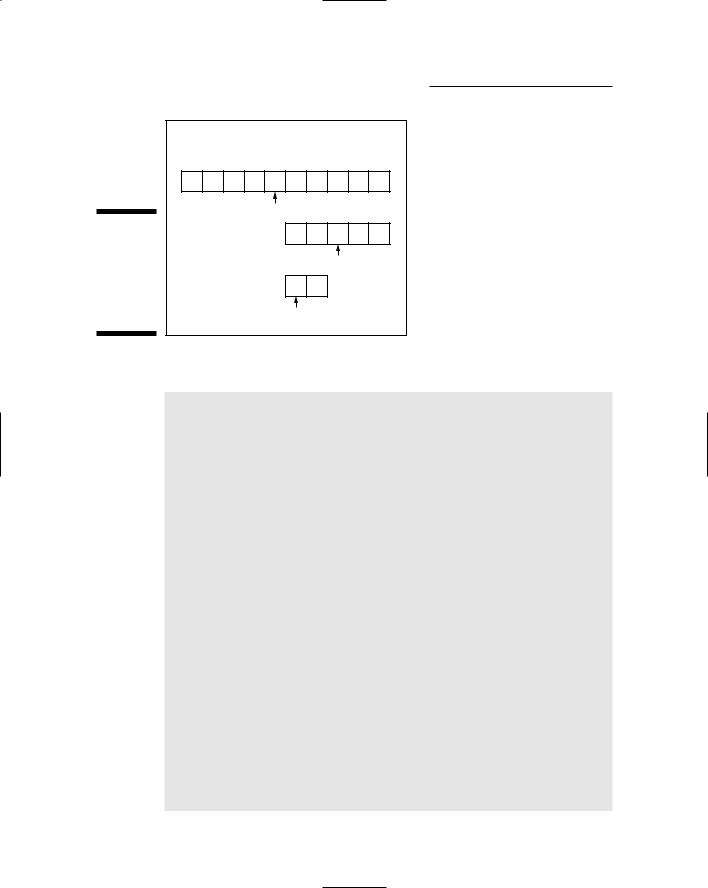
- •About the Author
- •Dedication
- •Author’s Acknowledgments
- •Contents at a Glance
- •Table of Contents
- •Introduction
- •Who Should Buy This Book
- •How This Book Is Organized
- •Part I: Programming a Computer
- •Part II: Learning Programming with Liberty BASIC
- •Part III: Advanced Programming with Liberty BASIC
- •Part VI: Internet Programming
- •Part VII: The Part of Tens
- •How to Use This Book
- •Foolish assumptions
- •Icons used in this book
- •Why Learn Computer Programming?
- •How Does a Computer Program Work?
- •What Do I Need to Know to Program a Computer?
- •The joy of assembly language
- •C: The portable assembler
- •High-level programming languages
- •Database programming languages
- •Scripting programming languages
- •The program’s users
- •The target computer
- •Prototyping
- •Choosing a programming language
- •Defining how the program should work
- •The Life Cycle of a Typical Program
- •The development cycle
- •The maintenance cycle
- •The upgrade cycle
- •Writing Programs in an Editor
- •Using a Compiler or an Interpreter
- •Compilers
- •Interpreters
- •P-code: A combination compiler and interpreter
- •So what do I use?
- •Squashing Bugs with a Debugger
- •Writing a Help File
- •Creating an Installation Program
- •Why Learn Liberty BASIC?
- •Liberty BASIC is easy
- •Liberty BASIC runs on Windows
- •You can start using Liberty BASIC today
- •Installing Liberty BASIC
- •Loading Liberty BASIC
- •Your First Liberty BASIC Program
- •Running a Liberty BASIC program
- •Saving a Liberty BASIC program
- •Getting Help Using Liberty BASIC
- •Exiting Liberty BASIC
- •Getting input
- •Displaying output
- •Sending Data to the Printer
- •Storing Data in Variables
- •Creating a variable
- •Assigning a value to a variable
- •Declaring your variables
- •Using Constants
- •Commenting Your Code
- •Using variables
- •Working with precedence
- •Using parentheses
- •Manipulating Strings
- •Declaring variables as strings
- •Smashing strings together
- •Counting the length of a string
- •Playing with UPPERCASE and lowercase
- •Trimming the front and back of a string
- •Inserting spaces
- •Yanking characters out of a string
- •Looking for a string inside another string
- •Using Boolean Expressions
- •Using variables in Boolean expressions
- •Using Boolean operators
- •Exploring IF THEN Statements
- •IF THEN ELSE statements
- •Working with SELECT CASE Statements
- •Checking a range of values
- •Checking a relational operator
- •Boolean expression inside the loop
- •Looping a Fixed Number of Times
- •Counting with different numbers
- •Counting in increments
- •Anatomy of a Computer Bug
- •Syntax Errors
- •Fun with Logic Errors
- •Stepping line by line
- •Tracing through your program
- •Designing a Window
- •Creating a new window
- •Defining the size and location of a window
- •Adding color to a window
- •Putting Controls in a Window
- •Creating a command button
- •Displaying text
- •Creating a check box
- •Creating a radio button
- •Creating text boxes
- •Creating list boxes
- •Creating combo boxes
- •Creating group boxes
- •Storing Stuff in Text Files
- •Creating a new text file
- •Putting stuff in a text file
- •Adding new stuff to an existing text file
- •Retrieving data from a text file
- •Creating a new binary file
- •Saving stuff in a binary file
- •Changing stuff in a binary file
- •Retrieving stuff from a binary file
- •Creating a Graphics Control
- •Using Turtle Graphics
- •Defining line thickness
- •Defining line colors
- •Drawing Circles
- •Drawing Boxes
- •Displaying Text
- •Making Sounds
- •Making a beeping noise
- •Playing WAV files
- •Passing Data by Value or by Reference
- •Using Functions
- •Defining a function
- •Passing data to a function
- •Calling a function
- •Exiting prematurely from a function
- •Using Subroutines
- •Defining a subroutine
- •Passing data to a subroutine
- •Calling a subroutine
- •Exiting prematurely from a subroutine
- •Writing Modular Programs
- •Introducing Structured Programming
- •Sequential instructions
- •Branching instructions
- •Looping instructions
- •Putting structured programming into practice
- •The Problem with Software
- •Ways to Make Programming Easier
- •Breaking Programs into Objects
- •How to use objects
- •How to create an object
- •Creating an object
- •Starting with a Pointer
- •Defining the parts of a linked list
- •Creating a linked list
- •Managing a linked list
- •Making Data Structures with Linked Lists
- •Stacks
- •Queues
- •Trees
- •Graphs
- •Creating a Record
- •Manipulating Data in Records
- •Storing data in a record
- •Retrieving data from a record
- •Using Records with Arrays
- •Making an Array
- •Making a Multidimensional Array
- •Creating Dynamic Arrays
- •Insertion Sort
- •Bubble Sort
- •Shell Sort
- •Quicksort
- •Sorting Algorithms
- •Searching Sequentially
- •Performing a Binary Search
- •Hashing
- •Searching by using a hash function
- •Dealing with collisions
- •Picking a Searching Algorithm
- •Choosing the Right Data Structure
- •Choosing the Right Algorithm
- •Put the condition most likely to be false first
- •Put the condition most likely to be true first
- •Clean out your loops
- •Use the correct data types
- •Using a Faster Language
- •Optimizing Your Compiler
- •Programming Computer Games
- •Creating Computer Animation
- •Making (And Breaking) Encryption
- •Internet Programming
- •Fighting Computer Viruses and Worms
- •Hacking for Hire
- •Participating in an Open-Source Project
- •Niche-Market Programming
- •Teaching Others about Computers
- •Selling Your Own Software
- •Trying Commercial Compilers
- •Windows programming
- •Macintosh and Palm OS programming
- •Linux programming
- •Testing the Shareware and
- •BASIC compilers
- •C/C++ and Java compilers
- •Pascal compilers
- •Using a Proprietary Language
- •HyperCard
- •Revolution
- •PowerBuilder
- •Shopping by Mail Order
- •Getting Your Hands on Source Code
- •Joining a Local User Group
- •Frequenting Usenet Newsgroups
- •Playing Core War
- •Programming a Battling Robot
- •Toying with Lego Mindstorms
- •Index
- •End-User License Agreement

Chapter 21
Searching
In This Chapter
Performing a sequential search
Performing a binary search
Hashing
Picking a searching algorithm
Searching for data is the second most common activity (after sorting data) necessary for creating many types of programs. A program that stores
names and addresses, for example, needs to sort data and then use a search algorithm to find the data that you want (such as looking for all people who live in Los Angeles and whose last names begin with the letter M ).
To make searching easier, programs usually sort the data first before trying to search it. For more information about sorting, see Chapter 20.
An algorithm is just a fancy way of giving the computer specific types of instructions to accomplish a task. Choosing the right sorting and searching algorithms can make your program run quickly and efficiently. Choose the wrong sorting and searching algorithms and your program may run sluggishly, even for small amounts of data.
Searching Sequentially
A sequential search examines every possible item in a data structure (such as an array or linked list) until it finds what it’s looking for. This type of search is like looking for your car keys in your apartment by going through room
by room, looking in every conceivable location until you find your car keys. Although such a sequential search eventually turns up your car keys (assuming that they’re in your apartment in the first place), it may take a long time.

288 Part V: Algorithms: Telling the Computer What to Do
For small lists, a sequential search is simple to use and fast. But if you need to search large amounts of data, the sequential search bogs down rapidly. Imagine the futility of trying to find your car keys somewhere in the city of New York. That’s the type of task that a sequential search must face in searching through huge amounts of data.
A sequential search can start at either the beginning or the end of a list. It then proceeds to examine every item in the list until it finds the one item that it’s searching for. Then it stops. To see how a sequential search works, try running the following Liberty BASIC program:
MaxSize = 5
REDIM MyArray(MaxSize)
MyArray(1) = INT(RND(1) * 10) + 1
PRINT MyArray(1); SPACE$(1);
FOR I = 2 TO MaxSize
MyArray(I) = MyArray(I - 1) + INT(RND(1) * 10) + 1
PRINT MyArray(I); SPACE$(1);
NEXT I
INPUT “Which number do you want to find: “; FindMe
FoundIt = 0
FOR J = 1 TO MaxSize
IF FoundIt = 0 THEN
PRINT “Checking array location “; J
IF MyArray(J) = FindMe THEN
FoundIt = 1
END IF
END IF
NEXT J
IF FoundIt = 1 THEN
PRINT “Found it!”
ELSE
PRINT “The number you want is not in the list.”
END IF
END
This program works as follows:
1.The first and second lines create the variable MaxSize, set the value of MaxSize to 5, and define the array MyArray, which can hold five (the value of MaxSize) integers.
2.The third through ninth lines create a random number and store it in MyArray. Each additional random number is slightly larger than the previous one to create a sorted array of five integers. Then this group of lines prints the complete array on-screen for you to examine.

Chapter 21: Searching 289
3.The tenth line asks the user to type the number to find, which the program stores in the FindMe variable.
4.The eleventh line creates the variable FoundIt and sets its value to 0.
5.The twelfth through nineteenth lines start searching in MyArray for the number that the FindMe variable stores and print each array location that the program checks.
6.The twentieth through twenty-fifth lines print the message Found it! if
the program finds the number; if the program doesn’t find the number, it prints The number that you want is not in the list.
7. The twenty-sixth line marks the end of the program.
One advantage of a sequential search is that you can use it on both sorted and unsorted lists.
Performing a Binary Search
A sequential search starts from the beginning of a list and keeps trudging through the entire list from start to finish until it finds what it’s looking for. But if a list is already sorted, you can shorten the search by using a binary search. (See Chapter 20 for more information about sorting data.)
A binary search divides a long (previously sorted) list in half. If the list that you want to sort contains 10 numbers that it arranges from smallest (on the left) to largest (on the right), the computer looks to see which half of the list (5 numbers on the left and 5 numbers on the right) contains the number for which it’s searching.
Figure 21-1 shows a binary search trying to find the number 37 in a list containing 10 numbers. First, the binary search algorithm cuts the long list in half and examines the number in the middle of the list. Because the list contains 10 numbers, the binary search examines the fifth number in the list. In this case, the middle (fifth) number is 30, which tells the binary search algorithm that the number that it wants (37) must lie in the right half of the list.
Then the binary search takes the right half of the list (consisting of five numbers) and cuts this list in half, which points to the third number in the list (59). Because 59 is larger than 37 (the number that it’s trying to find), the binarysearch algorithm determines that the number 37 must lie in the left side of this part of the list.
The left part of this list contains just two numbers, 37 and 45. With two items in a list, the binary search algorithm needs to look at only the first number in this list, which is 37. Fortunately, 37 is the number that the binary search is looking for, and so the search is over.

290 Part V: Algorithms: Telling the Computer What to Do
|
|
Using a binary search |
|
|
|||||
|
|
to find the number 37 |
|
|
|||||
4 |
15 |
16 |
29 |
30 |
37 |
45 |
59 |
82 |
93 |
|
|
Start search here |
|
|
|
||||
Figure 21-1: |
|
|
|
|
37 |
45 |
59 |
82 |
93 |
A binary |
|
|
|
|
|||||
|
|
|
|
|
|
|
|
|
|
search cuts |
|
|
|
|
|
Search here |
|
||
a list in half |
|
|
|
|
|
|
|||
|
|
|
|
37 |
45 |
|
|
|
|
until it finds |
|
|
|
|
|
|
|
||
what it’s |
|
|
Found number here |
|
|
||||
looking for. |
|
|
|
|
|||||
To see how the binary-search algorithm works, try the following program:
MaxSize = 5
REDIM MyArray(MaxSize)
MyArray(1) = INT(RND(1) * 10) + 1
PRINT MyArray(1); SPACE$(1);
FOR I = 2 TO MaxSize
MyArray(I) = MyArray(I - 1) + INT(RND(1) * 10) + 1
PRINT MyArray(I); SPACE$(1);
NEXT I
INPUT “Which number do you want to find: “; FindMe
Left = 1
Right = MaxSize
Time2Stop = 0
WHILE Time2Stop = 0
Half = INT((Left + Right) / 2)
IF FindMe < MyArray(Half) THEN
Right = Half - 1
ELSE
Left = Half + 1
END IF
IF (FindMe = MyArray(Half) OR Left > Right) THEN
Time2Stop = 1
END IF
WEND
IF FindMe = MyArray(Half) THEN
PRINT “Found it in location “; Half
ELSE
PRINT “The number you want is not in the list.”
END IF
END

Chapter 21: Searching 291
The binary search program works as follows:
1.The first and second lines create the variable MaxSize, set the value of MaxSize to five, and define the array MyArray, which can hold five integers (the value of MaxSize).
2.The third through ninth lines create a random number and store it in MyArray. Each additional random number is slightly larger than the previous one to create a sorted array of five integers. Then this group of lines prints the complete array on-screen for you to examine.
3.The tenth line asks the user to type the number to find which the program stores in the FindMe variable.
4.The eleventh line creates the variable Left and sets its value to 1.
5.The twelfth line creates the variable Right and sets its value to MaxSize, the maximum size of the array.
6.The thirteenth line creates the variable Time2Stop and sets its value to 0.
7.The fourteenth line is the start of a WHILE WEND loop that repeats until the binary search finds the FindMe number in the array or until it searches the entire array and can’t find the FindMe number.
8.The fifteenth line creates the variable Half, which divides the list in half and stores the integer result. (So if you divide an odd number, the integer result drops all fractions, so INT(5 / 2) equals 2.)
9.The sixteenth through twentieth lines look for the FindMe number in the left half of the array. If the FindMe number is less than the item that the middle of the array stores, the Right variable is set to Half - 1. Otherwise, the value of the Left variable is set to Half + 1. By lowering the value of the Right variable and increasing the value of the Left variable, the program can keep track after it searches all numbers in the array without finding the number that it’s looking for. The moment that the Left variable becomes greater than the Right variable, the program knows that the number it’s searching for isn’t anywhere in the array.
10.The twenty-first through twenty-third lines check to see whether it can find the FindMe number or until the program determines that the FindMe number doesn’t exist. If this situation occurs, the value of the Time2Stop variable is set to 1.
11.The twenty-fourth line marks the end of the WHILE-WEND loop.
12.The twenty-fifth through twenty-ninth lines print the message Found it in location, following that message with the array position. If it doesn’t find the number in the array, the program prints The number that you want is not in the list.
13.The thirtieth line marks the end of the program.
